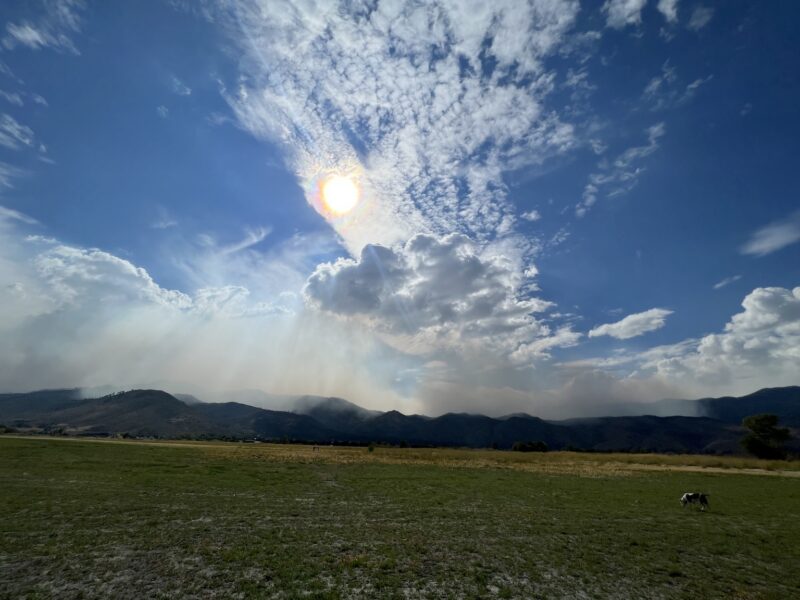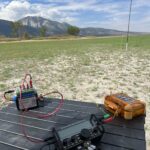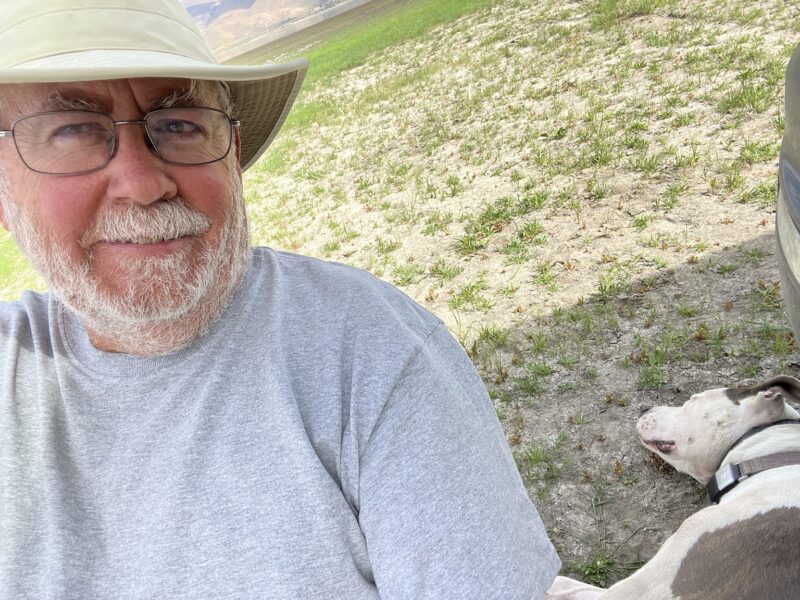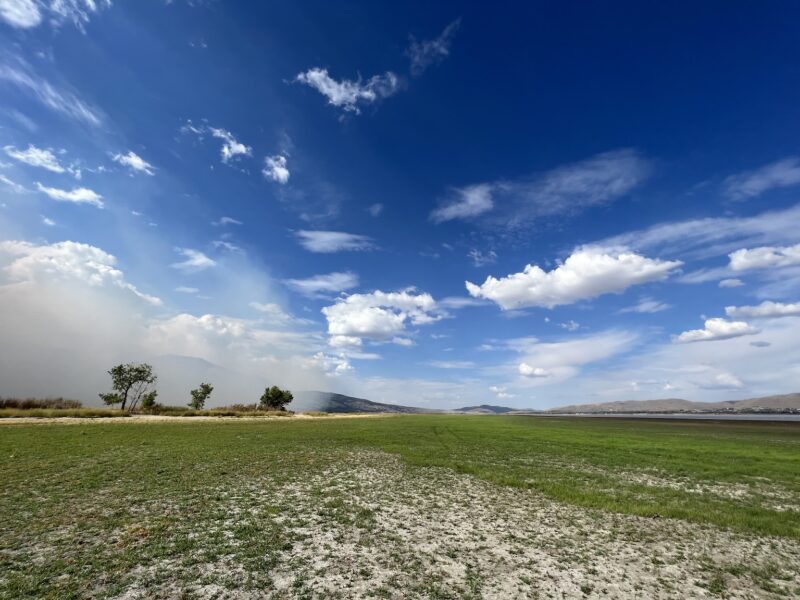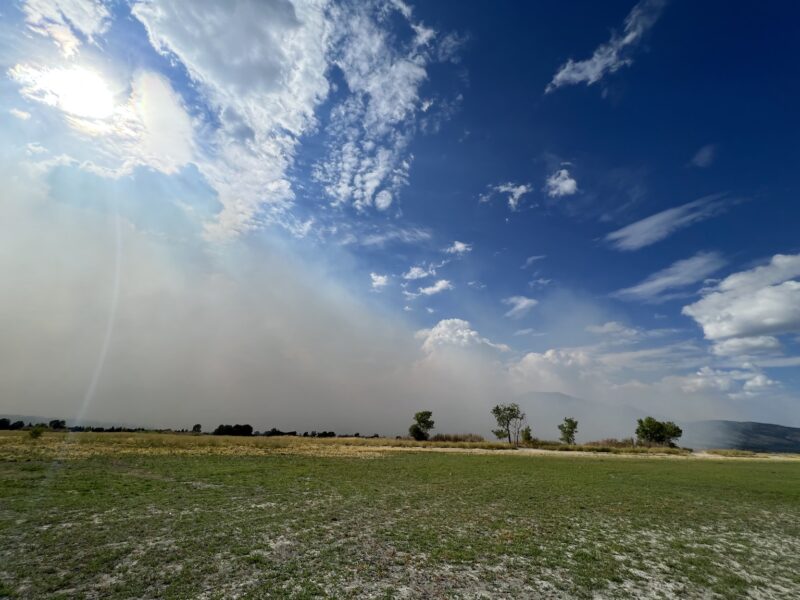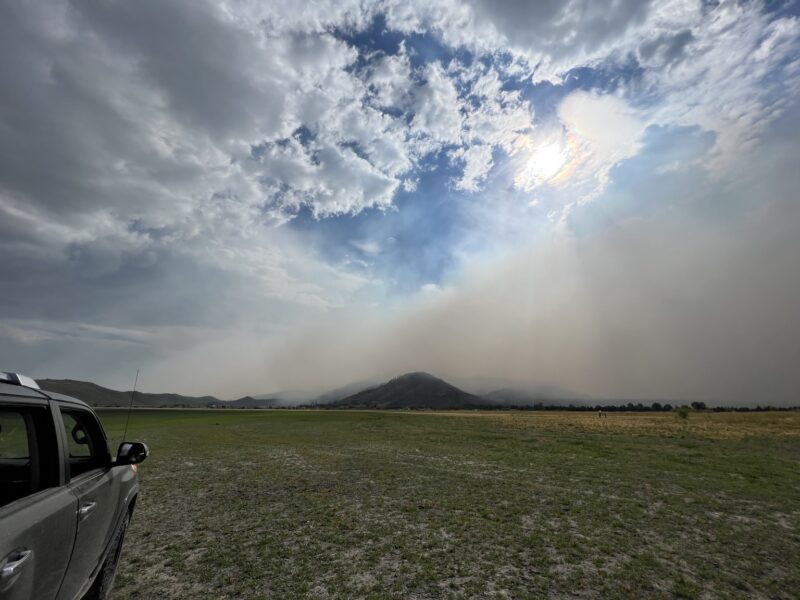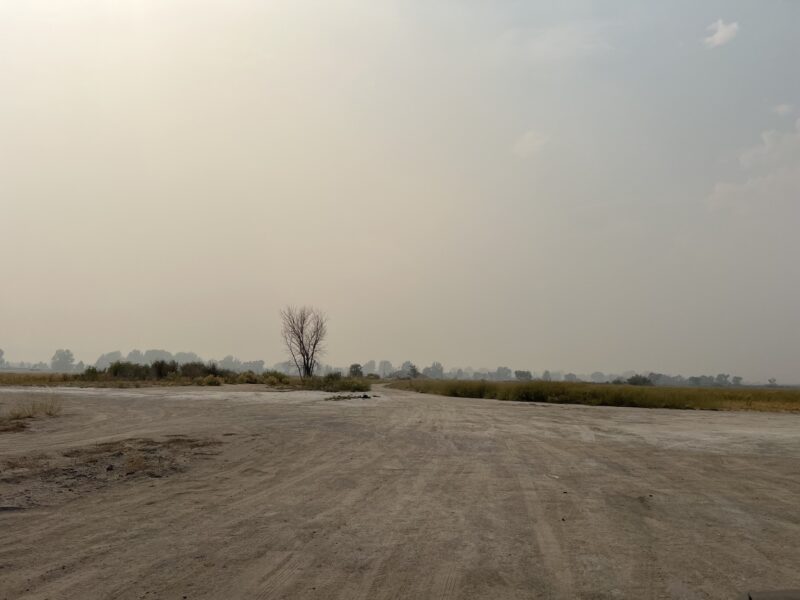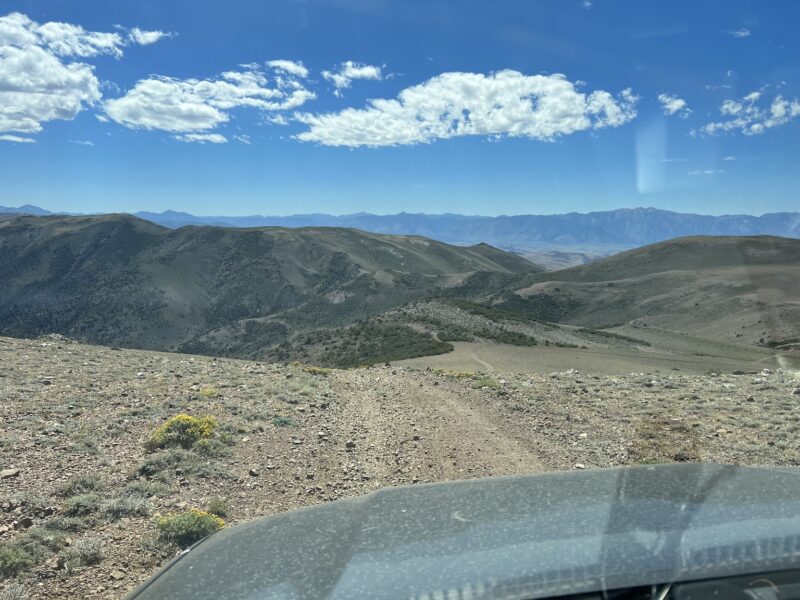
After another long week, I spent some time Friday afternoon looking for a summit to activate. Both Mt. Siegel (W7N/TR-003) and Oreana Peak (W7M/TR-004) were on my list from a previous search. Because of their proximity, they looked to be doable in a single trip.
So, the stage was set for a twin activation on Saturday morning, 13 August 2022.
I loaded up a few things to take with us, mostly water, a snack, and checked that I had radio equipment. I roused The Girl into the rig, locked the front door of the house, and we headed out. We made a quick stop at McD’s for a bite, a coffee, and a water and then headed south on US395. I stopped in Minden to refuel the rig and buy a sandwich.
We continued through Gardnerville and then took Pine Nut Road east for a few miles. I missed the turn and found myself at the transfer station, but that was not a big deal as it was only a quarter of a mile. We continued on an increasingly rough road to the Public Lands access. That road went on another mile or so and because Lone Pine Canyon Road.
That is, if it can be called a road. It is really just a two-track trail that varies from packed soil and sand to some rounded cobble to boulder size rocks. The pace declined to under ten miles per hour.
Yet, the trail was not particularly difficult. It was just rough. We continued to climb up the valley, in and out of the drainage, picking our way through the rocks when necessary and driving over them as needed.
We entered a burned out area, the Manzanite standing skeletal with burned bark and bare white limbs stretched to the sky in a dying supplication for mercy that did not come. The grasses were already returning, but the shrubs will be a long time before they grow again.
This part of the drive out was just a slog. I stopped a couple of times to let The Girl out to sniff and pee. I will say I took advantage of the stops a time or two myself. I guess the coffee was working.
As we turned south along Buckeye Creek, there were places that the trail crossed old flood outwashes. These could be trip-enders with very angular (and sharp) outcrops of rocks. They could tear a sidewall easily. I took care crossing through these areas and worked to keep my head clear of the usual woolgathering I do when driving boring roads.
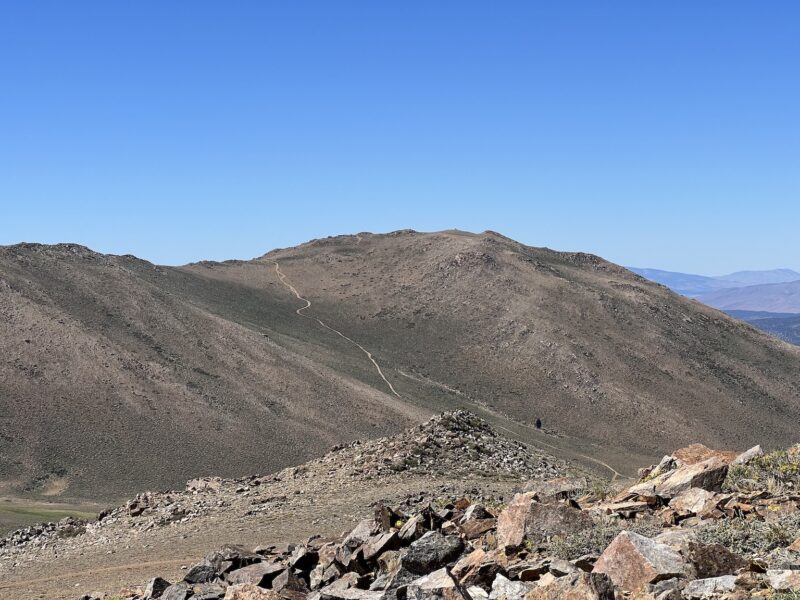
I hit the intersection of the trail to Oreana Peak and paused. I could see the trail up to Oreana Peak and it looked easier than the one up to Mt. Siegel. Given how far out I was, I wanted to do both peaks on this trip.
The trail up to Mr. Siegel was not too bad. The 4Runner crawled up just fine. But I was very careful to watch for rocks. It would be easy to tear a sidewall on this trail. There were just enough loose rocks that the rig slipped a bit now and again. A torn sidewall would have been a very bad afternoon.
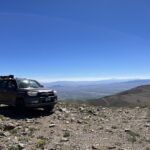
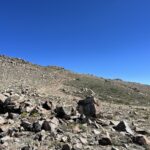
I looked around a bit and noticed the 4Runner down at the staging area. That called for a pause for an image. So I made it.
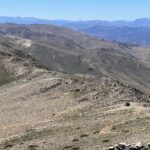
My cell service was a little iffy, but I did get a spot out for my location. I started calling and made a number of contacts right away, including a few summit-to-summit contacts. It was not difficult to get my quota.
But, I noticed that running my iPhone with the screen bright and the lock time set to five minutes was a problem. The sun shining down on us was overheating more than The Girl and I — it was overheating my iPhone. Given I log my contacts on my phone this could be a problem.
As happened during my activation of Chickadee Ridge, my phone was turning down the screen brightness to reduce heat. Given I had my quota, I decided to call it and get ready to do the other peak.
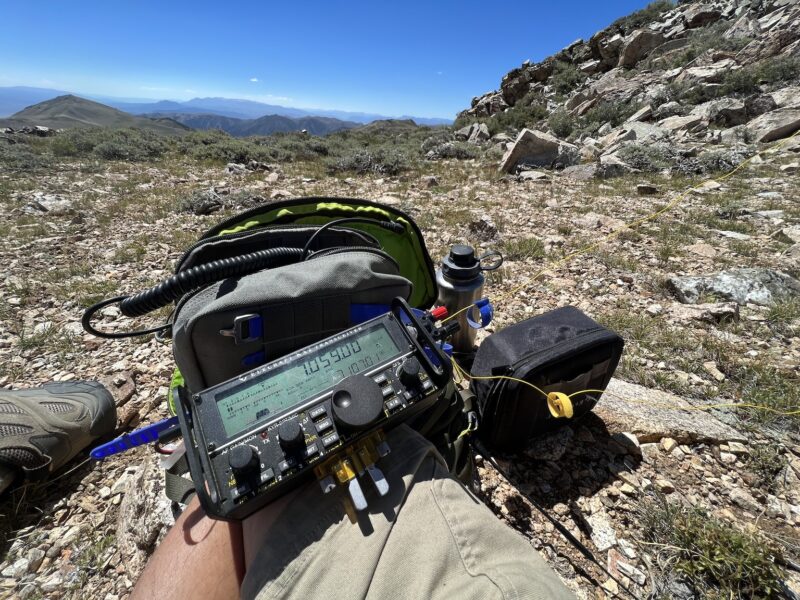
I gave The Girl some more water and we headed back down the two-track. It was not a long hike, but care was required as the trail was fairly steep and rocky. A fall would not be a good thing.
While working my way down the trail, I paused to capture an image of Orean Peak. The trail to Mt. Siegel is in the foreground. The trail to Oreana Peak is in the midground with the peak in the background. It is quite breathtaking.
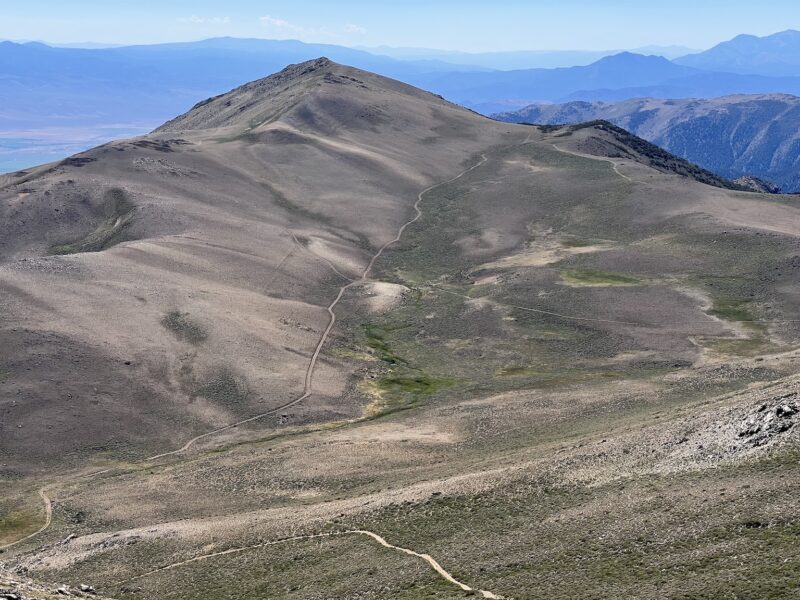
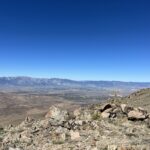
I was not disappointed. The rig skittered and slid a bit on the way down, even in low-low. I had to work the brakes a bit and be careful to avoid a slide-out and tire damage. So I took my time and was very careful.
I made it down with no problem. I made the right to the Oreana Peak trail along Buckeye Creek (not much of a creek at this location) and headed back up.
When we got up to the Oreana Peak staging area, it was clear this was another bare summit with no shade. There was not enough rock outcrop to make shade. And the sun was just miserable. And, I was getting tired from the required focus, the altitude, and the heat.
So I put up the antenna, setup the radio, and made my contacts. The Girl was so hot she was crowding me trying to get into my shade. That wreaked a bit of havoc on my sending. I do not need help with that, particularly with the Elecraft key!
I kept the iPhone in my shade and that helped keep it from overheating again. I now carry a notebook and a pen in a cargo pocket. I can always log contacts on paper.
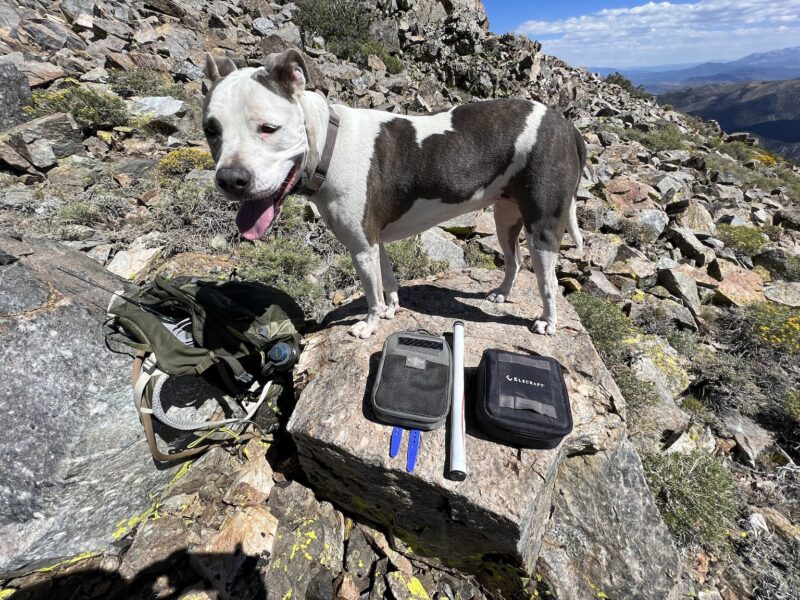
While we were sitting there, resting a bit (and she trying to crowd into my shade still), I heard something that sounded like a pickup scrabbling up the trail to the staging area.
“That’s strange,” I thought, “I did not see a vehicle approaching up the trail.”
Then the wind hit us. It was a strong gust and I was glad that the mast was put away. It might have been damaged. The wind was strong enough to rattle the rocks on the slopes of Oreana Peak.
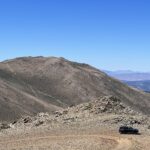
It was not long and we were back at the rig. I got out more water for The Girl. I dumped the pack into the rig. I drank water myself. I was gassed… not completely, but I was damned tired.
So I put us back into the rig and we started the long trail back home. It was about two hours from US395 to where we were. It would be about two hours back. And I needed to be focused for the drive.
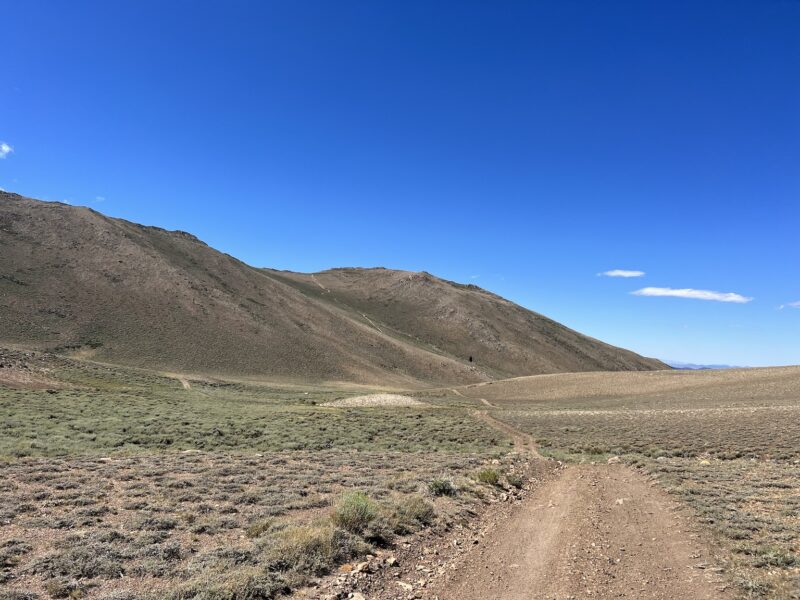
But we made it. As were were exiting Lone Pine Canyon, my buddy Greg called. “Are you home yet?”
“Nope. I’m still working my way down the trail. I’m about 15 or 20 minutes from the highway.”
“I thought you’d be home by now!”
“No… it is a long way out there and the trail is pretty rough. But I’ll be home soon. Thanks so much for calling and checking on me.”
We chatted a bit. Then he headed off for supper. I continued the drive.
Before long the trail turned into a road. Then the road got better. I no longer had to be as focused on navigating rocks and other obstacles. The Girl was settled into her seat, after having a couple of bouts with FOMO that there might be critters out there.
As I drove into Gardnerville, I started to think about supper… and the day. It was a learning experience for me. It was a long day. It was completely worth taking the time to do the second peak because of the long drive out there. I was hungry and tired.
On the way home I decided to stop at one of my favorite Mexican restaurants, Francisco’s. Some hot chow and una Margarita Grande sounded so good. Well, maybe dos Margaritas…
As I continue to activate SOTA peaks, I continue to learn things about operating and the support equipment I need to make this more fun. This outing was satisfying, but not fun.
- The issue of the iPhone overheating is a problem. It is my primary logging tool for portable operations. I need a way to keep it shaded so it does not overheat. Or, I need to change the way I log contacts such that the iPhone is no longer part of the system.
- The radio also gets hot. To date, it has not gotten hot enough to shut down. But, it might. That would be a show-stopper. I need to mind the radio temperature. Some shade would keep it a lot cooler.
- Sitting on a rock is not fun for this skinny-assed old man. I have a foldable chair. It has to go into the pack so I have a place to sit.
- A (very) small table would make summit operating a lot more comfortable. The portable table I have is to heavy to pack. That is a problem with a solution.
- The factory key for the Elecraft radios (the KX2 and KX3) does not work well for me. That might be a topic for another weblog entry. Nonetheless, it is a decent backup (for now), but should not be my primary key.
- The AME key works reasonably well for a field key. Holding it in my hand is not the best answer. The leg strap is better, but not perfect.
- I am afraid to be strapped to the radio. Sera can be impulsive and I might need to move quickly before she can get into trouble. I am not sure how to solve this problem.
- Although I really like running the antenna directly from the radio, this has its own issues. If the wind rises suddenly, the pressure on the mast creates a risk of dragging the radio off its perch. A hard landing might damage a (very) expensive radio. I need to think about this problem and develop a solution.
- Francisco’s is not a bad way to end a SOTA (or POTA) day!

